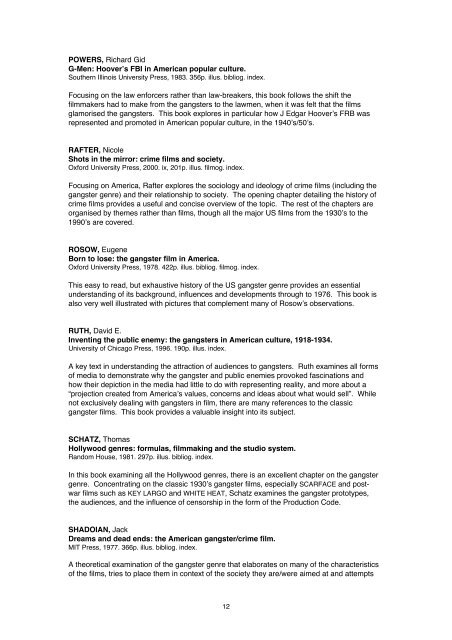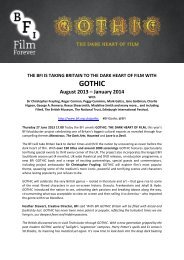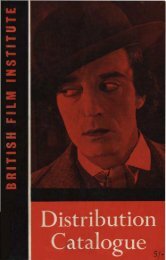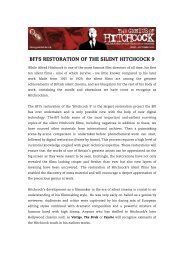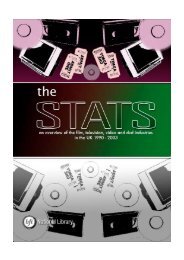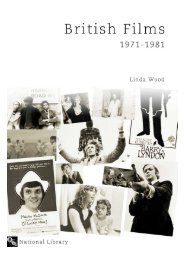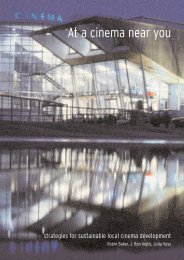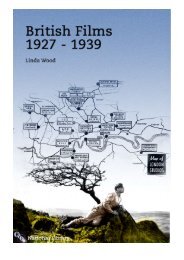16 + GUIDE - British Film Institute
16 + GUIDE - British Film Institute
16 + GUIDE - British Film Institute
You also want an ePaper? Increase the reach of your titles
YUMPU automatically turns print PDFs into web optimized ePapers that Google loves.
POWERS, Richard Gid<br />
G-Men: Hoover’s FBI in American popular culture.<br />
Southern Illinois University Press, 1983. 356p. illus. bibliog. index.<br />
Focusing on the law enforcers rather than law-breakers, this book follows the shift the<br />
filmmakers had to make from the gangsters to the lawmen, when it was felt that the films<br />
glamorised the gangsters. This book explores in particular how J Edgar Hoover’s FRB was<br />
represented and promoted in American popular culture, in the 1940’s/50’s.<br />
RAFTER, Nicole<br />
Shots in the mirror: crime films and society.<br />
Oxford University Press, 2000. ix, 201p. illus. filmog. index.<br />
Focusing on America, Rafter explores the sociology and ideology of crime films (including the<br />
gangster genre) and their relationship to society. The opening chapter detailing the history of<br />
crime films provides a useful and concise overview of the topic. The rest of the chapters are<br />
organised by themes rather than films, though all the major US films from the 1930’s to the<br />
1990’s are covered.<br />
ROSOW, Eugene<br />
Born to lose: the gangster film in America.<br />
Oxford University Press, 1978. 422p. illus. bibliog. filmog. index.<br />
This easy to read, but exhaustive history of the US gangster genre provides an essential<br />
understanding of its background, influences and developments through to 1976. This book is<br />
also very well illustrated with pictures that complement many of Rosow’s observations.<br />
RUTH, David E.<br />
Inventing the public enemy: the gangsters in American culture, 1918-1934.<br />
University of Chicago Press, 1996. 190p. illus. index.<br />
A key text in understanding the attraction of audiences to gangsters. Ruth examines all forms<br />
of media to demonstrate why the gangster and public enemies provoked fascinations and<br />
how their depiction in the media had little to do with representing reality, and more about a<br />
“projection created from America’s values, concerns and ideas about what would sell”. While<br />
not exclusively dealing with gangsters in film, there are many references to the classic<br />
gangster films. This book provides a valuable insight into its subject.<br />
SCHATZ, Thomas<br />
Hollywood genres: formulas, filmmaking and the studio system.<br />
Random House, 1981. 297p. illus. bibliog. index.<br />
In this book examining all the Hollywood genres, there is an excellent chapter on the gangster<br />
genre. Concentrating on the classic 1930’s gangster films, especially SCARFACE and postwar<br />
films such as KEY LARGO and WHITE HEAT, Schatz examines the gangster prototypes,<br />
the audiences, and the influence of censorship in the form of the Production Code.<br />
SHADOIAN, Jack<br />
Dreams and dead ends: the American gangster/crime film.<br />
MIT Press, 1977. 366p. illus. bibliog. index.<br />
A theoretical examination of the gangster genre that elaborates on many of the characteristics<br />
of the films, tries to place them in context of the society they are/were aimed at and attempts<br />
12


